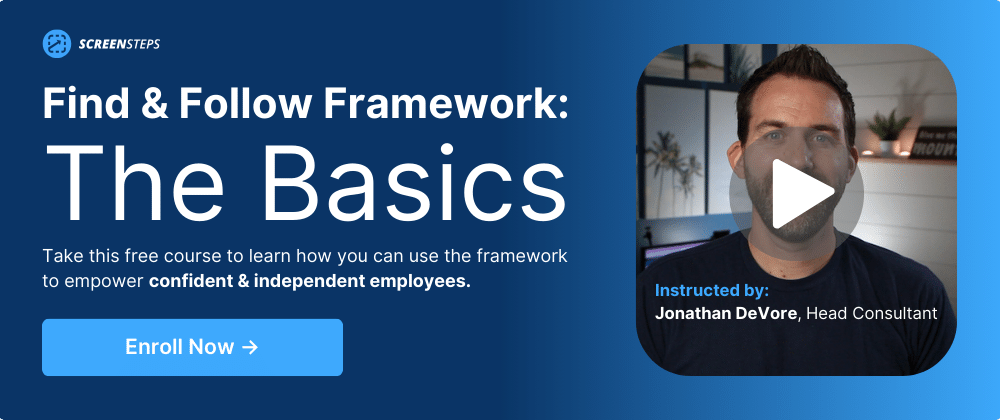3 Common Challenges With Knowledge Management (+ How to Solve Them)
Is knowledge management causing your company a headache?
When it comes to creating and organizing your company's knowledge resources, it is challenging to know the best practices.
Working for ScreenSteps — a knowledge ops solution — I've helped dozens of companies organize and optimize their standard operating procedures (SOPs) to improve employee efficiency and decrease training times.
And it typically involves overcoming one or more of these three challenges.
Watch this 3-minute video a brief overview of three common challenges companies face with knowledge management. The video includes steps to overcome those challenges.
For more detailed solutions and additional resources, keep reading after the video.
Challenge #1: End-users can't find the guides they need
Do your end-users struggle to find the right guides? It's frustrating for end-users to have to dig into your knowledge management system to find the guide they need.
Often, end-users need to click through a series of folders to find the right guide or try multiple phrases in the search bar. And sometimes that still doesn't bring up the guide they need!
If it takes more than a few seconds for your end-users to navigate to the guide they need in your knowledge management system, that's too long.
Solution: Optimize your search
Make finding easier by optimizing your search.
Create a centralized hub for all of your company's standard operating procedures (SOPs), policies, how-to guides, and other knowledge resources. Some of the best systems for organizing knowledge are knowledge base software or a knowledge ops platform.
In your centralized hub, organize your guides. You don't want deep folders!
Write article titles that use phrasing the end-users would say. These titles could be in the form of a question like, "How do I make a direct deposit without the account number?" Don't use corporate jargon in your article titles.
Finally, add tags and keywords that trigger the search engine to bring up the most relevant guide when people are searching.
RESOURCES
Learn more about how to make your digital guides more findable.
Challenge #2: Employees are overwhelmed by information overload
Most companies have a lot of policies and procedures that they expect their employees to learn. Memorizing that information can be overwhelming.
Luckily, most companies have some form of documented procedures. Unfortunately, those SOPs often end up looking like a full-blown manual instead of a step-by-step guide. These guides are often too technical for your frontline employees.
The guides are impossible for employees to follow.
Because of that, employees end up asking their supervisors or their neighbors how to handle different procedures.
Solution: Write recipes
Make your digital guides look like recipes. What do I mean by that? That means you aren't explaining every term and every little detail surrounding a procedure. Instead, you give instructions that direct an employee on how to handle a procedure on their own.
Don't clump articles into one big super article. Instead, break your articles into single procedures and interlink them.
If you are using a knowledge management platform, you can link your articles. This is helpful if you want to provide links to sub-procedures or define terms.
RESOURCES
Learn more about how to make your digital guides more followable.
Challenge #3: Employees don't trust the knowledge base
Even if you have a knowledge base to manage your company knowledge, you may have the challenge that employees don't trust your knowledge base.
This happens when your knowledge base is incomplete (i.e. has knowledge gaps) or is inaccurate (i.e. articles aren't up to date).
An incomplete or outdated knowledge base causes employees to make mistakes, so they deem your knowledge base unreliable. Instead, they resort back to tribal knowledge. That means they ask neighbors/supervisors for help or wing the process.
Solution: Provide a feedback loop
If you want to prevent your knowledge base from becoming inaccurate and incomplete, you need to provide your employees with a way to request new articles and updates.
Provide a feedback loop. That way, end-users can let you know if your guides are missing information or have outdated information.
Ideally, your knowledge base will have authoring tools that allow you to quickly make changes to your articles and push those updates to your end-users immediately.
RESOURCES
Learn more about how to make your digital guides more reliable.
Discover a more effective way to manage your company's knowledge
When it comes to managing and transferring your company's knowledge, there are a lot of moving pieces. It is difficult to put together a strategy that both helps train your employees and supports them on the job.
That's why ScreenSteps created the Find & Follow Framework. The framework helps companies in 2 ways. Companies can:
- Train their employees in 30 days or less
- Create a system for writing, organizing, and continuously optimizing digital guides
Companies that have adopted Find & Follow have onboarded new hires up to 87% faster and dropped the average task time by 45%.
Ready to escape these common knowledge management challenges?
Take this free 30-minute course that introduces the Find & Follow Framework. You can also download a free Find & Follow playbook here to learn more about how Find & Follow can help you improve your knowledge management strategy.


.png)

